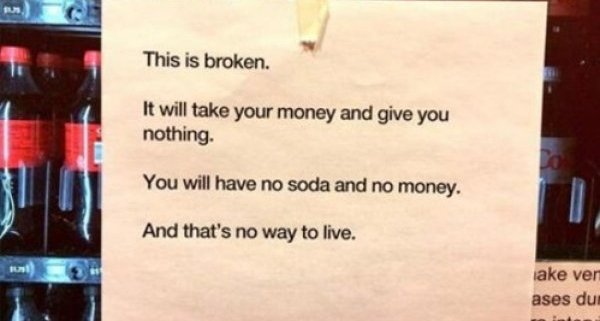Extinction
Extinction: When an observed behavior goes away entirely because of the reinforcement procedure that has been applied to the situation. An extinction burst, occurs when the reinforcement that caused a behavior has been removed, initially there will be an increase in the observed behavior. This is an attempt of the subject to try to obtain the motivational operant by causing more behaviors. After the outburst, the behavior then decreased to the point of extinction.
An example of this can be seen at a vending machine that does not deliver a soda after you have paid and pushed the button. In previous experience, putting in money and pushing the button delivers the soda. This behavior has a strong history of reinforcement. When the situation changes and the soda machine stops delivering the soda, the reaction is to start pushing the buttons madly. The soda button pushing behavior previously delivered soda. Now it does not. More button pushing ensues. The mad button pushing is the extinction burst. After the extinction burst, the button pushing behavior is decreased and then stops.
Warning: Thinning the schedule of reinforcement may actually entrench the behavior more effectively, making extinction more difficult to obtain in the future. Extinction involves reducing the maintaining reinforcers to absolute zero.
Resistance to extinction refers to the amount of responding by an individual after reinforcement has been removed. Intermittent schedules of reinforcement, thinner schedules and variable schedules are associated with a greater resistance to extinction.
Possible unwanted side effects of extinction:
- Increased behavior (extinction burst)
- Spontaneous recovery – the behavior comes back for a brief time for no apparent reason
- Some desirable behaviors are sometimes accidentally “ignored” and may cease
Note: Increasing the opportunities for extinction may actually reduce target behavior more quickly. Increasing the opportunities for extinction means that there are more offers for the chance for the behavior to be emitted and the reinforcement denied more often. This will speed up the extinction process.
Resistance to Extinction: Refers to an individual continuing to respond even after reinforcement has been removed from the equation. Some things that can cause resistance to extinction include: thinner reinforcement schedules, intermittent schedules of reinforcement, and variable schedules of reinforcement. All these things cause behavior to persist.
Extinction is highly recommended to use in any case where punishment procedures are implemented. Additionally, in any case of punishment or extinction, introduce the correct replacement behavior.




Good article. Helpful.